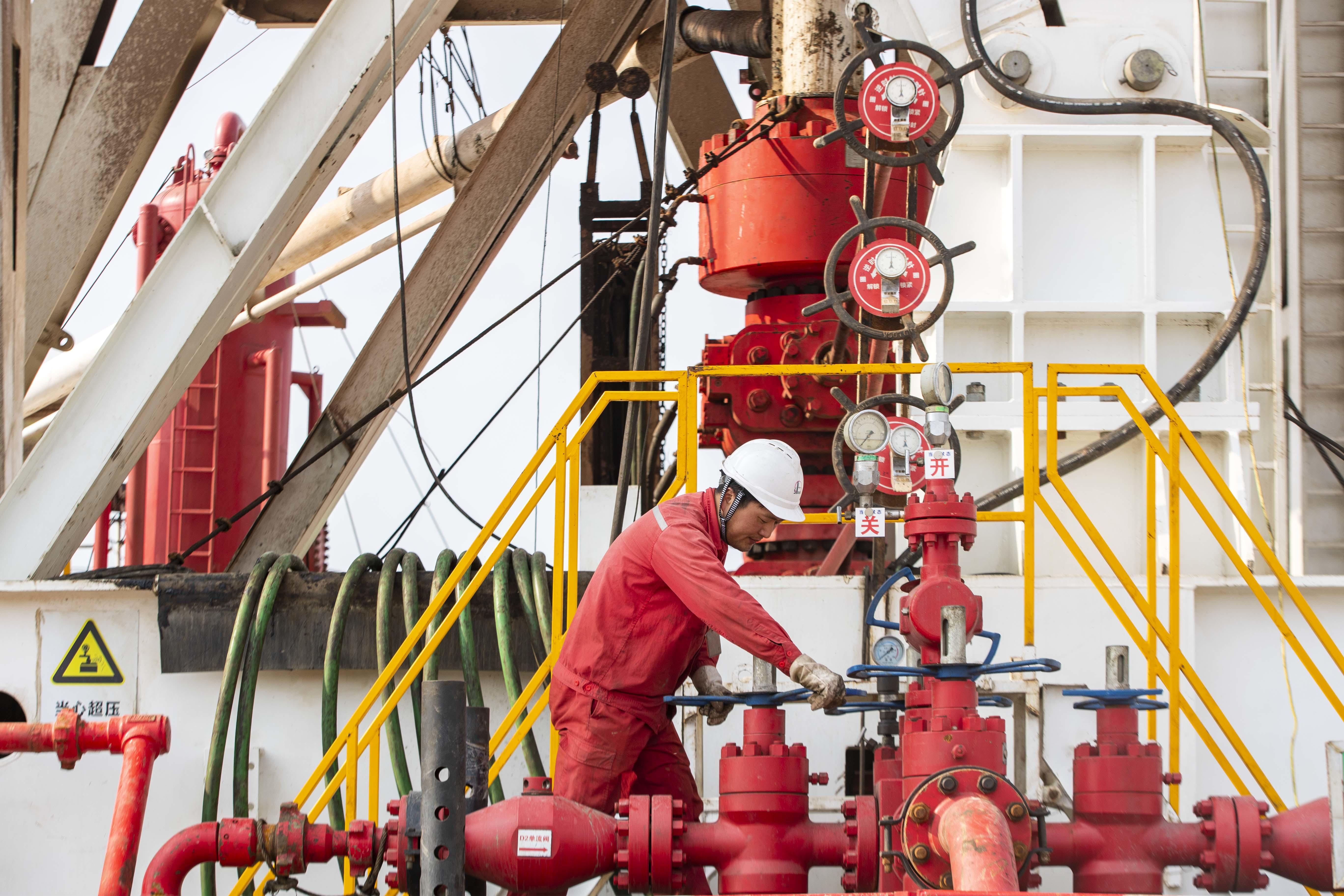Pickup in Chinese economic activity, optimized COVID-19 measures to boost off-take after fuel usage contracted last year
 A technician conveys work schedule at an offshore drilling platform in the South China Sea in January. (PHOTO / XINHUA)
A technician conveys work schedule at an offshore drilling platform in the South China Sea in January. (PHOTO / XINHUA)
Oil and gas consumption in China is expected to rise this year as the economic recovery will rapidly increase energy off-take, experts from industry and policy think tanks said.
Oil consumption is expected to grow by 5.1 percent year-on-year to 756 million metric tons in 2023, with refined oil products up 9.1 percent to 398 million tons, driven by an overall recovery in the country's economy, a report released in April by the Beijing-based Economics and Technology Research Institute showed.
The institute, which is affiliated with the country's largest oil and gas producer and supplier, China National Petroleum Corp, said demand for natural gas will also rise rapidly from last year, with annual consumption expected to climb at a rate of 5.2 percent to reach 386.5 billion cubic meters.
Other agencies and organizations have also echoed the upbeat projections.
The Organization of the Petroleum Exporting Countries estimates that China's oil demand will grow by 510,000 bpd in 2023.
OPEC attributes the growth to optimized COVID-19 measures and a stronger economy compared with 2022, when the country's oil use contracted for the first time in years due to the pandemic.
China's oil demand is on course to rebound and a plan to expand fiscal spending is also likely to support demand, OPEC said in a note.
The Economics and Technology Research Institute said crude oil production in China has been increasing for four consecutive years, with total annual production reaching 205 million tons in 2022, surpassing 200 million tons for the first time in six years. Domestic natural gas production and pipeline gas imports have also grown rapidly.
Last year, China's newly discovered geological reserves of oil were approximately 1.46 billion tons and newly discovered geological reserves of natural gas were over 1.2 trillion cubic meters, maintaining a high growth rate, it said.
Stable prices, supply
Zhou Xiwei, an economist with the institute's energy strategy research department, said China's oil and gas industry managed to ensure energy supply and stabilize prices last year, providing strong support for domestic economic growth despite the severe and complex changes in the international energy situation.
Domestic energy companies, including CNPC, China National Offshore Oil Corp and China Petrochemical Corp (Sinopec), have stepped up domestic oil and gas exploration and exploitation in recent years to boost output, while expanding international oil and gas exploration and trade to secure adequate energy supply, she said.
CNPC said its oil and gas output hit new records in 2022, with crude production reaching 105 million tons and natural gas output hitting 145.3 billion cubic meters. Natural gas accounted for 52.4 percent of the company's total production measured by oil and gas equivalent, it said.
 A worker conducts shale oil extraction in Taizhou, Jiangsu province, in April. (TANG DEHONG / FOR CHINA DAILY)
A worker conducts shale oil extraction in Taizhou, Jiangsu province, in April. (TANG DEHONG / FOR CHINA DAILY)
CNOOC's oil and gas production also touched a record high last year, hitting 120 million tons of oil equivalent, with domestic crude oil and natural gas production up by 3.39 million tons and 2.7 billion cubic meters year-on-year, respectively. The increase in crude oil production accounted for over 60 percent of the country's total increase, it said.
The company's overseas oil and gas production rose to 46.24 million tons of oil equivalent in 2022 as it continuously strengthens international energy cooperation while optimizing asset layout in countries and regions participating in the Belt and Road Initiative, it said.
CNOOC currently owns 43 assets in 22 economies and the proportion of oil and gas production in the BRI region has increased to 31 percent of total overseas oil and gas production.
China imported 508 million tons of crude oil last year, with an import dependency rate of 71.2 percent. It imported 152.07 billion cubic meters of natural gas last year, with an import dependency rate of 40.2 percent, said the China Petroleum and Chemical Industry Federation.
The federation said it expects China's oil import dependency rate to remain at around 70 percent in the medium to long term.
According to the federation, while growth in domestic refining capacity slowed last year, with a total refining capacity of 924 million tons per year, China still maintains its position as the world's largest refiner.
Ethylene production capacity has grown rapidly for the fourth consecutive year, with a total production capacity of 49.53 million tons per year, surpassing the United States and rising to the top spot globally, it said.
Sinopec, the world's top refinery by capacity, aims to lift crude throughput by 3 percent year-on-year in 2023 as it expects domestic demand for refined products and chemicals to grow rapidly on an overall upturn in domestic economic performance.
The refiner targets processing 250 million tons, or 5.03 million bpd of crude, in 2023, up 3.2 percent from realized throughput of 4.88 million bpd in 2022, but below the 5.14 million bpd in 2021.
While ensuring energy security will remain the primary task this year and growth in crude oil and natural gas production in 2023 will be maintained, Zhou of the CNPC institute said China will also continue to add more renewable power generation capacity this year with a focus on deeper integration of solar and wind power to the grid.
The China Electricity Council, a trade body of power producers, said installed solar and wind capacity will exceed hydropower for the first time in 2023. It expects China to add nearly 100 gigawatts of solar capacity to reach 490 GW in 2023, which will be the largest solar capacity added in a single year compared with around 85 GW of capacity added in 2022.
The council also expects China's wind capacity to reach around 430 GW in 2023, a growth of around 61 GW from 2022. In comparison, the capacity additions were 71 GW in 2020, 48 GW in 2021 and 40 GW in 2022.
China will add about 45-50 GW of coal-fired generation capacity in 2023, and around 200 GW of renewable capacity, according to Caroline Zhu, senior analyst with S&P Global Commodity Insights.
In recent years, China accounted for roughly 44 percent of additional global renewable capacity and more than 73 percent of Asia's renewables capacity addition. This trend is expected to continue in 2023, she said.
zhengxin@chinadaily.com.cn